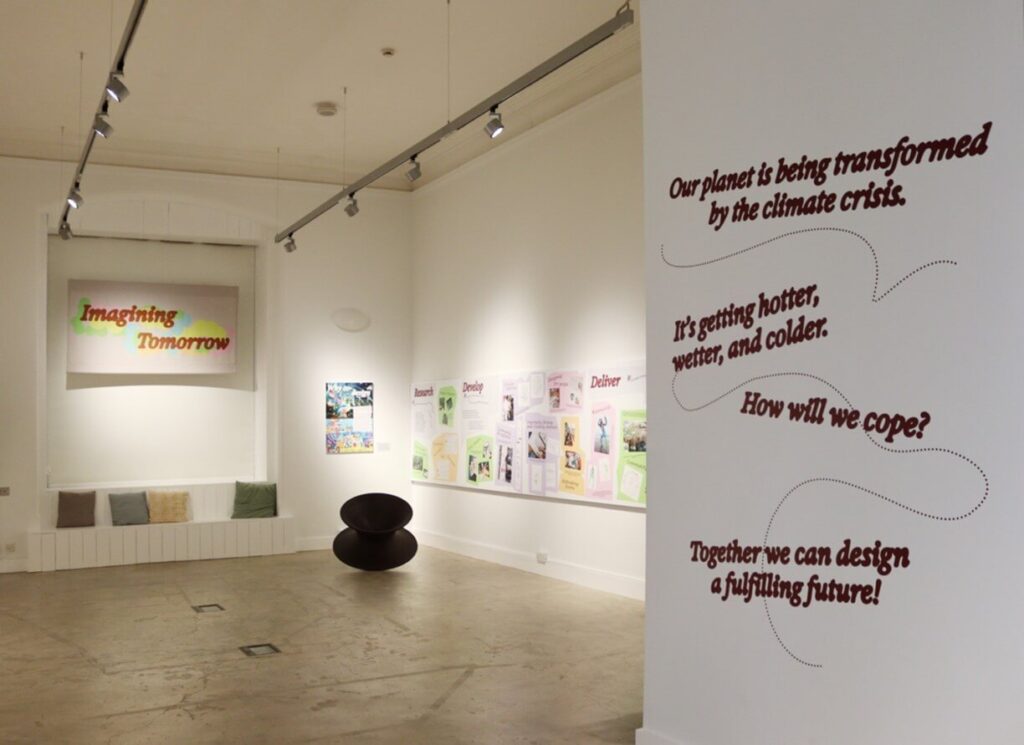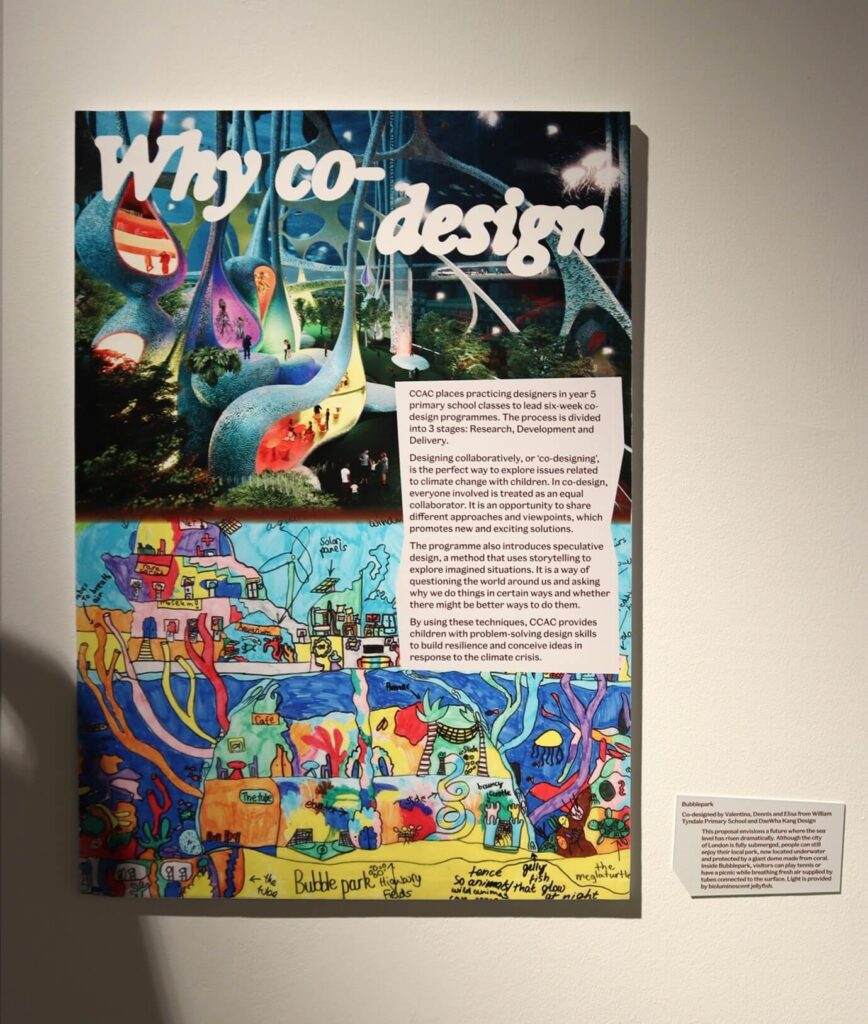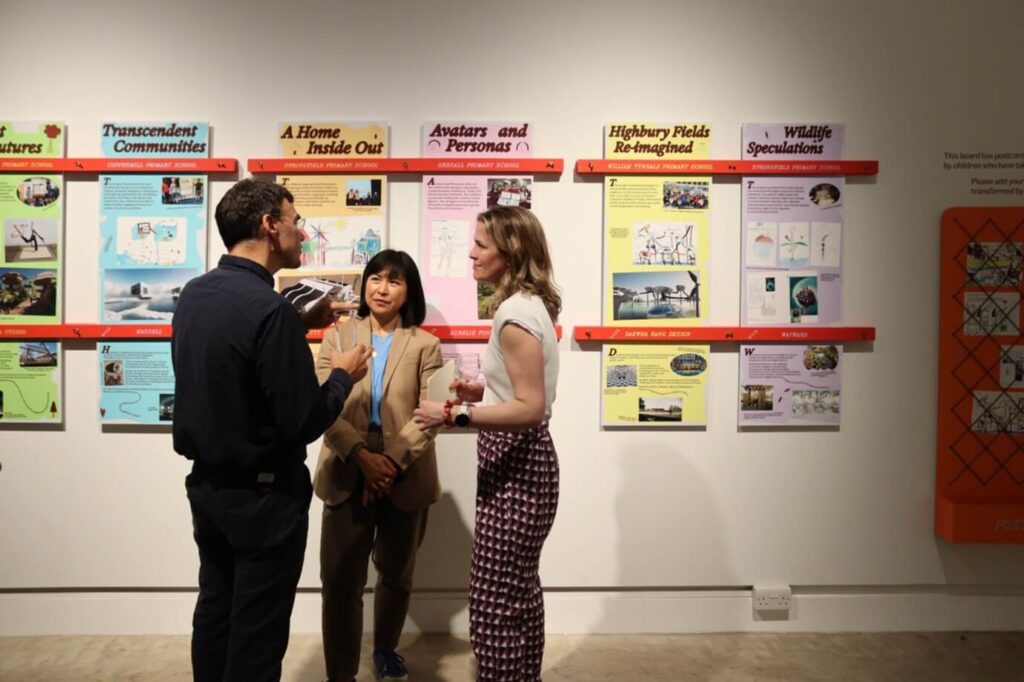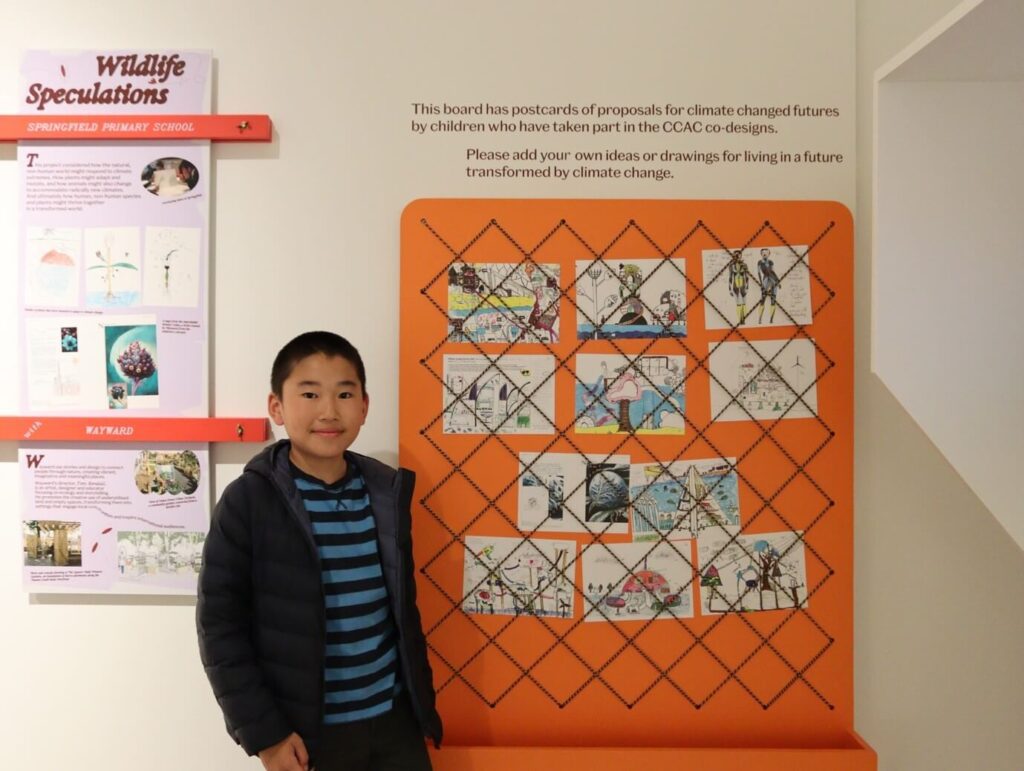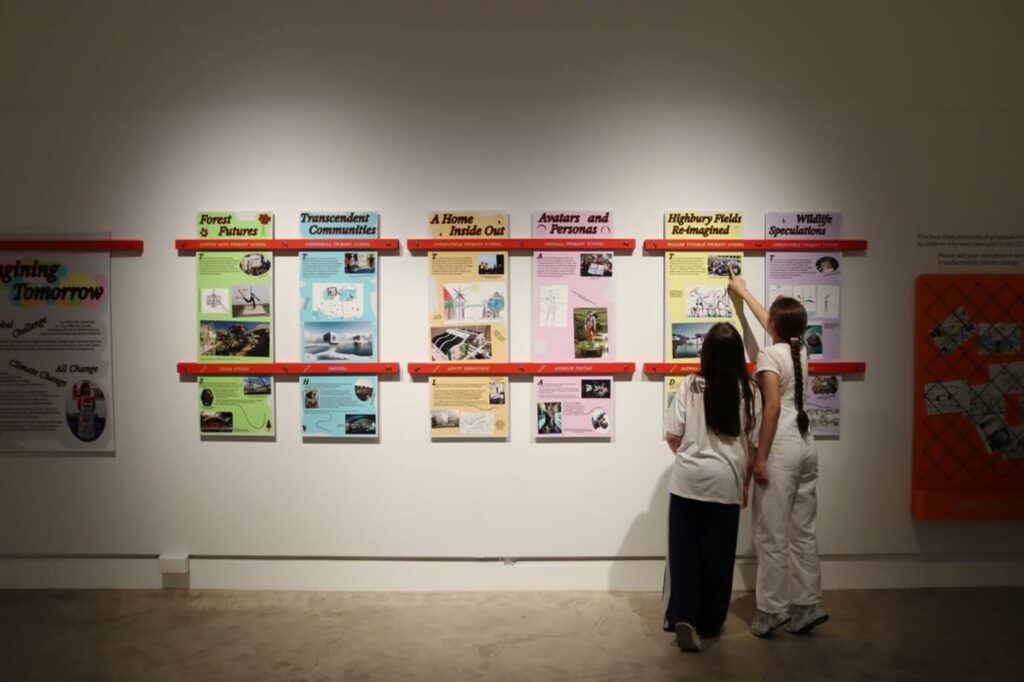Gallery
Speeches
I’m really delighted to be here. I remember a conversation back in February 2020: we were sworn to secrecy about a very special exhibition that might happen. And I can’t quite believe that we are here today – because, yes, it was linked to the V&A, and we absolutely couldn’t say anything. But it’s a real delight to be here with you tonight to celebrate how far Climate Change All Change has come and all that it has achieved.
Some of you will probably know of Susan Scott’s book about fierce conversations. Fierce in a positive way. It’s not an angry conversation. It is essentially about those conversations that can change the trajectory of either a person’s life or a company. In 2019 I was very, very fortunate to have such a conversation with DaeWha Kang. The conversations that followed in 2019 and 2020, have changed the trajectory for education – because this programme really is the future of our education system. Such conversations can be remembered as a turning point. I’m so delighted that conversation led us to where we are today.
As a school leader, I absolutely would argue that I have the best job in the world. I get to be with children every single day, to teach them the knowledge and the skills to help them navigate a very fast and rapidly changing world.
As we all know, even since 2020, the world is a very different place. We have all faced many challenges in that period. And it is our job as educators to help children to navigate increasing anxiety and stress.
How can we do this? Well, we can do this positively. We can do this by teaching children that they have a voice, that they are able to come up with solutions that make a difference.
So, I want to share with you our school’s mission statement, what we are aiming to do in terms of education. There are children from our school in this room, and I’m delighted and thank you for coming. They’ll be able to tell you that our mission statement is about reaching for your future. It is about respect, enterprise, ambition, confidence and happiness.
That structure reflects CCAC’s mission. The charity absolutely lives by those principles. And it is these principles of education that we should be giving our young people – to be respectful of one another in the way that we talk to each other. So, in this CCAC project you are collaborating with each other, you are collaborating with designers, with different people from different professions. You are having this respectful, thoughtful conversation with not only children but also with adults.
We are also teaching children to be respectful of their environment, to be thinking about sustainability – all the skills that are so important in our world today.
We are teaching our children to be ambitious. This is a very ambitious project. From working with CCAC, helping them with the pilot project in early 2020 – we’ve now repeated the programme for three years running, following the pause during the pandemic – we know this project can work, this programme absolutely can work, and I truly believe it should be in every single school. It really should become part of our education system.
It is ambitious, yet it is achievable. Why? Because it teaches and pulls together the objectives of the art and DT curriculum, of the climate literacy curriculum, of the literacy curriculum, because we are enabling children to present and to give their ideas, to build confidence, to access information, to read about it, to write and express facts and emotions. What better way to really motivate our young people?
Schools have to compete with lots of different challenges, as we all do in our various professions. Access to technology has greatly evolved: children now literally have the world at their fingertips. Of course, we know that’s a fantastic opportunity and place for children to learn, but it does also provide challenges. The way CCAC uses technology shows children how we can use critical thinking skills, how can we use technology in a really powerful and meaningful way.
I know that this is just the beginning for CCAC. In the space of four years, the programme has been rolled out in many schools. We even had a teacher from Berlin come to view the programme because she was so inspired by it. She’d heard about it and wanted to see how it could potentially be put into her school. It really does have that power to transform education, not just in this country, but globally.
In terms of confidence, I mentioned that we are seeing more children with high levels of anxiety and stress: this programme really does give them a voice. We want to equip children to say, ‘you can make a change. You can come up with these solutions’. And designers, thank you to everyone, I know some of you are in the room, I imagine you have learned a lot from our young people.
Look at this collaboration! The children have given a few different ideas and then you have transformed them. This type of collaboration is immensely powerful.
All of this, of course, feeds into our last core value, which is happiness, because we can help children to develop some skills, enabling creative problem solving, and showing them that they can make a difference. I have seen a lot of different programmes in education and can see how unique CCAC is. When I had a conversation with DaeWha and Linda and David and Kimberly, it was so refreshing to see other professions and other professionals coming into school and saying, we can work with you, we can do this, let’s collaborate and look at the education system differently. I do believe that the education system has a little bit of work to do as well, but we are absolutely willing to make those changes. What better way really to motivate our young people, and to teach them that there are so many other opportunities out there. Some young people might like to be a YouTuber or a footballer… But let’s really open up those opportunities and show them what else is out there.
What I really like is how inclusive this programme is. In our school – and you will hear this from most mainstream schools now – there are many, many children with different needs. That is wonderful, we want that diversity; and we want those children to be working together. We had, in our last CCAC project, a cohort with quite a number of needs. Those children just loved this programme. So, it really is for all learners, and that inclusivity is absolutely key.
I genuinely believe this is the beginning of the journey for CCAC. Thank you for all your support; and for those across the globe, because we have the technology, we can spread that word. I know that the CCAC programme will absolutely continue to grow. Thank you too to all of the wonderful children – and there are many of them in the room – we can see how creative you are; it’s wonderful to see all of your work: well done!
Last week, we launched the CCAC Young Designers Award, supported by the Linbury Trust. This call is open to emerging designers in various disciplines who have some practice experience to work in schools on our co-design projects. Applications from all backgrounds are welcome. If you know anybody who might be interested, please direct them to the CCAC website. Or you can speak to a member of the CCAC team here tonight.
I’m going to finish with a few thanks. On behalf of CCAC’s Board of Trustees: huge thanks to the V&A, particularly Tristram Hunt, Helen Charman, Alex Newsom for their constant support, and Yvonne McKenzie, and Barbara Nassisi, the designers of the exhibition. Also, a very big thank you to all the schools and to all the children who have taken part and to all the teachers. There are also some teachers in the room this evening. Thank you so much for also being here and for teaching our children.
Thank you to our advisors as well; and again thank you for being here tonight to celebrate this wonderful programme.
Thank you so much, everybody.
Thank you. Thank you. Thank you.
Why are we interested in working with CCAC? What is so special about this project? It’s because it puts young people at the core and promotes understanding and awareness of the power of creativity, of design, of architecture to change our futures for the better: whose world will young people inherit? Their world; your world.
We’re delighted to see so many children here with us, we are celebrating your creativity; and the work of our designers and architects and engineers who have been so generous with their time; their expertise; their vision. It’s so inspiring to look around and see the creative agency and the vision, really, for a better and different world.
And my goodness, don’t we know that this is the pressing issue of our time.
One element of my role is as director of Young V&A: we are just approaching our first year, first anniversary in Bethnal Green. We co-designed that museum with environmental sensitivity. What was the issue that came up time and time again when we were working? Young people, families, parents – from birth to 40 years – climate change. How can we create a world that is really engaged with the challenges of climate change, that is positive, that is optimistic, that has that fantastic design mindset which is solutions-focused.
We talk about how designers have their feet on the ground in the real world, but their head in the clouds, in a space of imagination, curiosity, what might be, what if, and this is what this fantastic display really demonstrates – that power of design.
So, there’s a fantastic synergy and alignment between CCAC and the V&A. This show in the Learning Centre, is at the heart of all of the learning programmes for V&A. We have over 100,000 learners come through this space every year, and they will all see this display. The teachers who come to our programmes will see the display. They will be inspired. They will be catalysed to engage with these themes, to look at the fantastic work that’s happening, the partnerships between schools and studios, and take this into their own curricula.
We have an important event nationally on the 4th of July [2024 General Election] with our new administration position on climate change in climate education. CCAC is a fantastic example of what that might look like in the curriculum. So, there’s an enormous scope actually for further collaboration, both through structured programming with CCAC and more widely. This weekend is the Great Exhibition Road Festival. We will have tens of thousands coming through the museum. Our families, our young people will see this display. So, any young person here this evening, your work will be inspiring. Both your peers, children your age, older children, other teachers, professional creators who will look at your work will think, yes, you’ve done something really constructive and positive in this space.
Now before I introduce our next speaker, Sophia Gavalda, Headteacher at William Tyndale Primary School, I just wanted to refer to a book which I found quite inspiring, by William MacAskill: What We Owe the Future. What MacAskill talks about is long-termism, and the idea of being a good ancestor.
Now museums are about stewardship, yes, stewardship of the past, but also for the future.
Climate Change All Change is an incredible programme that really cares about the lives of young people, our planet, the power of creativity. What about the yet unborn? What about stewardship for generations to come? We know that things need to change, the curriculum needs to change. The way that we frame the power of creativity needs to change. We need to see this as a driving force for solutions for the future. MacAskill talks about the power of creativity to improve the well-being of future generations while giving them, in principle, good luck. And he argues that protecting future generations should be a key priority of our time amongst others.
I think this is what the CCAC project, its partnership and vision, the determination of David and DaeWha and everyone else involved in this project really have a commitment to the now and to the next. And that is what creativity and the power of design is about.
So, I hope you feel this evening celebrated. Thank you so much to Climate Change All Change. Thank you so much to all the creatives. You’ve knocked our socks off with the rendering, the envisioning, all the ideas of our young people. You’ve shown us what creative collaboration looks like in practice. It’s incredibly inspiring. It’s also kind of serious stuff. It really matters. And thousands upon thousands of young people and teachers and their families will be coming through this space. Let’s hope we get some brilliant pick-up and the comms when the press release goes out on Monday. This will then connect with our manifestos for our next administration, who will really take this very seriously and start to reposition climate education and creativity and design in the curriculum.
So, with no further ado, Sophie Gavalda headteacher of William Tyndale School.
Thank you.
